How and how to paint a cast-iron bath: an overview of the best restoration methods
Each product has its own service life, which sooner or later ends. Any thing once becomes worthless, and cast-iron bathtubs are no exception. Time and water have a negative effect on it and lead to the destruction of the enamel coating.
Agree, changing the bath is expensive and time-consuming. A more practical solution is to restore the plumbing yourself.
We will tell you how and how to paint a cast-iron bath, give recommendations for choosing a method, and also give step-by-step instructions for updating the product.
The content of the article:
Benefits of Cast Iron Bath Restoration
The enamel coating of the bath becomes thinner over time, rust appears on it under the influence of water, and if measures are not taken in time, the process may become irreversible. The bottom can simply rust to holes, and then the bath can no longer be saved.
The bath, covered with rust and limescale, looks, to put it mildly, not aesthetically pleasing. Undoubtedly, to put a new bath will be the only right decision if it is planned to make major repairs, change tiles and plumbing. However, if the repair is still far away, then buying a new bath will bring more problems than joy.
Modern cast-iron bathtubs are not cheap, and a considerable amount will also have to be paid for delivery. Due to the heavy weight of the product, dismantle the old and install a new bath Not sure it's going to happen. You need to either ask friends and neighbors, or hire people, which again costs.
Most likely, you will have to make repairs, even if it was not planned.
At the same time, the cast-iron bathtub, having lost its appearance, has not lost a very worthy performance, and can still serve faithfully to its owners. If there are no significant chips and cracks, you can restore the product with your own hands, and quickly enough, without dirt and high costs.
Another significant argument in favor of the restoration: the classic cast-iron bathtubs of the old type are superior in quality to modern analogues, whose service life does not exceed fifteen years.
Basic ways to update coverage
Today, there are three ways to update a cast-iron bath:
- Paint the surface with special enamel.
- Apply liquid acrylic.
- Insert an acrylic liner into the bath.
Each version of the restoration of the old bath has both advantages and disadvantages, which we will consider in detail below. To cover a cast-iron bathtub with enamel or acrylic, it is not necessary to be a specialist, this work can be done independently. The main thing is the correct choice of composition and exact adherence to the application technology.
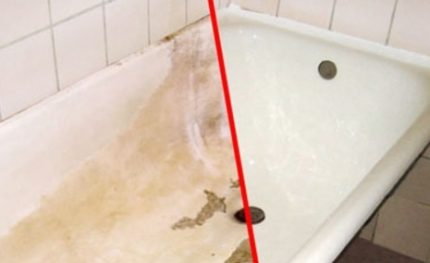
You can also install an acrylic liner with your own hands, but this work is more subtle and requires certain skills, so in this case it is better to resort to the services of specialists.
Surface preparation before painting
Regardless of how the cast-iron bath is painted, the surface must be carefully prepared. This is a very important stage that cannot be missed. Proper surface preparation is 99% success.
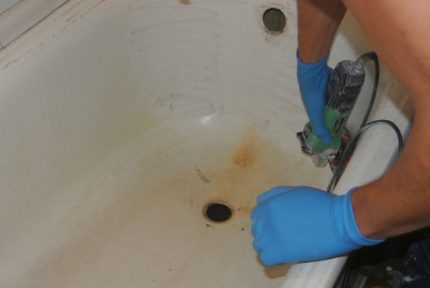
First of all, the cast-iron bath needs to be washed and degreased well. Dirt and grease interfere with adhesion, prevent the solution from absorbing well into the surface and nullify all restoration work. In the near future, new enamel may crack and peel off in areas where fat deposits remain.
For cleaning and degreasing, acidic household chemicals are suitable. Very efficiently cleans the bath with oxalic acid - the bath is treated with a solution and left to act for 10-15 minutes.
But she is very aggressive, and when working, it is necessary to use protective equipment for hands and respiratory organs. Wear rubber gloves and a respirator.
After treatment, rinse the bath well, and even better, fill it with water and hold for 20 minutes, then let it dry. Now, no less important work remains to be done - surface treatment with an abrasive, with which old enamel is removed, and the surface of the bath becomes rough, thereby providing better adhesion of materials.

Rust bath areas should be cleaned down to metal so that in the future it does not appear through a new enamel coating. After cleaning and polishing the surface, vacuum the bathtub to remove dust and small particles from its surface, and then again treat it with an acid-based liquid detergent.
Pour it into the bath and rub it well over the entire surface, leaving it to work for about an hour and a half. After that, fill the bathtub to the brim with water and let it stand for about an hour.
It is recommended to repeat the washing procedure at least 2-3 times, and then dry the surface with a hairdryer. To avoid clogging the siphon with dyes, disconnect the bath from the sewer.
Before applying the composition, the cup must be carefully inspected. Identified defects must be eliminated, for details, see this article.
If there are chips and cracks on the surface, they must be puttied and then treated with sandpaper, after which the dust formed must be removed again. This completes the preparation process, you can begin to stain.
Enamel bath restoration
Enameling a cast-iron bathtub is an old time-tested method that has been used for a very long time. But it should be distinguished professional enameling, which is subjected to the bath during production, and home painting with enamel.

In the first case, professional compositions are used that require preliminary heating of cast iron to a certain temperature. In this way, it is impossible to paint a cast-iron bath at home, and it is not necessary, since today there are easy-to-use and inexpensive enamel dyes for self-application.
Advantages and disadvantages of the method
Among the advantages of this method of painting can be identified:
- inexpensive cost;
- lack of installation work;
- can be used for both cast iron and steel surfaces.
However, this method also has disadvantages:
- the coating is quite thin and brittle, enamel is very sensitive to household cleaners and shocks. Therefore, you will have to handle the bath very carefully so as not to inadvertently damage it;
- the coating does not eliminate strong defects: chips, dents, cracks;
- over time, yellowness forms on the surface;
- the enamel dries for a long time, the bath can not be used for about a week.
The service life of the coating is 5 to 9 years.Although for those who are planning to do repairs in the future and change the cast-iron bathtub to a new one, this period of operation will surely suit.
Overview of bath enamels
Question, what can be painted an old cast-iron bath, not at all idle, since ordinary enamels are not suitable in this case. It is necessary to use special formulations designed for bathtubs.
Before applying any of them, you need to study the instructions and observe the technology exactly, otherwise the coating will not please with its novelty for a short time and will quickly peel off.

Among the enamels of Russian production can be distinguished Epoxy 51 and 51C. Enamel consists of two components: epoxy resin and amine hardeners produced at chemical plants in Germany and America.
Before use, the ingredients are mixed with each other and applied to the surface of the bath. If desired, you can paint the surface in any color by adding color to the paint.
The composition is resistant and, if properly applied, can last up to 9 years. Enamel has a thick consistency, which is a certain difficulty in the work.
In addition, you need to take into account that the time of use of the prepared solution is no more than an hour, after which the mixture begins to harden and it becomes almost impossible to apply it to the surface.
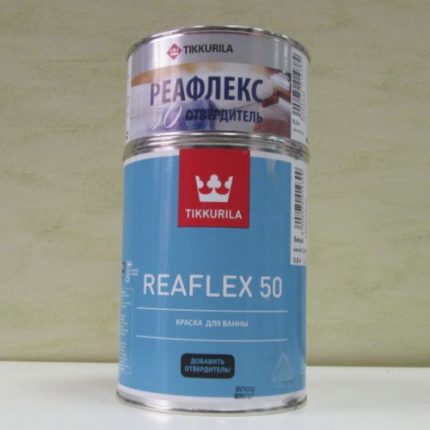
Finnish-made enamel is well established. Reaflex 50. It also consists of two components mixed together before application. The price of paint is somewhat more expensive than the domestic counterpart, but the high cost is fully offset by its excellent quality.
Enamel forms a durable and durable glossy coating on the surface of the bathtub in white or blue.
There are also Russian-made compositions that, although they are not as popular as the ones listed above, have quite worthy characteristics. This is enamel Svetlana and Fantasy, which are ready-made sets that include, in addition to the enamel and hardener itself, tools for processing the bath.
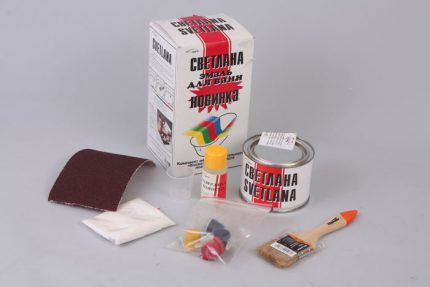
The process of coating the bath with enamel
If a two-component composition is used for staining, then before use it must be mixed in the proportion recommended by the manufacturer. But do not mix the whole amount at once.
The bath is painted in two layers. Therefore, the enamel must be divided into two parts and first part one portion, and after applying the first layer - the second. The duration of the solution is limited, and if you dilute all the paint at once, you may not have time to use it.

Enamels intended for home use have a fairly thick consistency, so it is recommended to add solvent 646 in a ratio of 10: 1 to the mixture. The first time the walls of the bathroom are painted with one, and the bottom with two layers.
If smudges have formed on the surface, they must be removed immediately with one upward brush stroke. If you let them dry, then nothing is impossible to fix. The second layer is applied 15-20 minutes after the first. During this time, the paint will dry out, and you will have time to part the second portion of enamel.
A new layer is applied in the same way as the previous one. You can use the bathroom no earlier than 4-7 days, the exact period is indicated in the instructions.
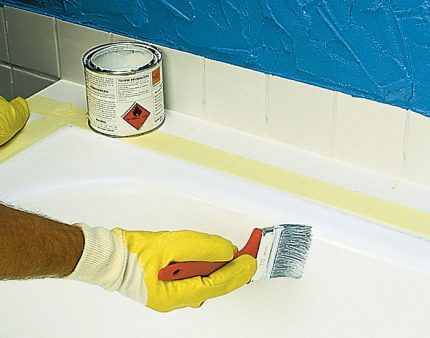
How to care for a renewed surface
The cast-iron bathtub has become as good as new, but do not forget that enameling the bathtub at home cannot provide such a high-quality and durable coating as originally applied during the production process. Therefore, the new surface must be treated very carefully, since its hardness is much lower than the original.
The bath must be protected from shock and prevent the fall of heavy objects; abrasives cannot be used to clean it. Surface baths can be washed only liquid formulations. It is also not recommended to pour too hot water into it.
Bath restoration with liquid acrylic
This method appeared relatively recently, about ten years ago. Today it is very popular and is used by both professional companies and home craftsmen. And this is no coincidence, it is considered the most effective way to restore the cast-iron bath.
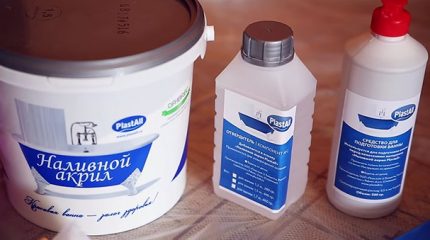
Advantages and disadvantages of the method
Bulk acrylic is a truly revolutionary tool that can literally transform an old cast-iron bathtub just a few hours before recognition.
This method has other advantages:
- high processing speed with minimal labor - a person who does not have special skills can easily do this job;
- the coating is perfectly smooth with a beautiful gloss;
- with proper application, the acrylic coating retains its performance and external characteristics for 15 years;
- acrylic is harmless, does not emit any unpleasant odors and does not require the use of special protective equipment;
- after three days the bath is completely ready for use.
Among the shortcomings, only one can be distinguished: a rather high cost bulk acrylic in comparison with enamel. Although the quality and durability of the coating completely compensate for this small minus.
Application of acrylic to the bath
Painting a cast-iron bathtub with acrylic is much faster and easier than enamel. For this, no rollers, no brushes, or other improvised tools will be needed. Acrylic is simply poured onto the bath, and then, under its own weight, gradually flows down the walls, forming an even and smooth coating.

Before the beginning acrylic bath treatments lay newspapers or cellophane on the floor so as not to stain the floor with a solution that will drain from the sides. Mix hardener with acrylic enamel. The container in which the hardener was located can be turned into a convenient watering can for applying acrylic, cutting off its nose at an angle.
Application of acrylic begins with the inner sides of the bath, those that are near the wall. Acrylic has a liquid consistency and quickly flows down. After the top edge of the bathtub is completely filled with mortar, start a new circle, but not from the sides, but from the middle of the side walls.
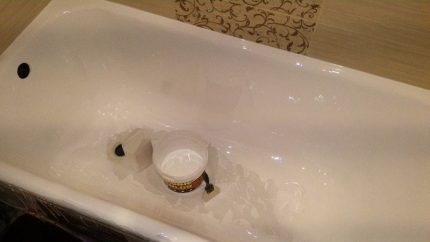
All acrylic flows down, but some places on the bottom and walls of the bath still remain uncoated. To close them, acrylic must be carefully leveled with a spatula over all fragments that are not flooded.
The mass flowing down, as a rule, rushes towards the drain, so that it does not clog, it is necessary to take it to the other side with a spatula. At this time, acrylic is already gaining viscosity and solidifies.
Acrylic is applied in one layer, and this completes the work of painting the bath. Now your task is to protect the surface from dust particles, debris or water droplets. All this can ruin the coating.Full hardening of the acrylic composition occurs within 1.5-2 days.
Liner restoration
The essence of the method is to install an acrylic liner in an old bath. The product is made from sheet acrylic, which is heated to the desired temperature and squeezed out using a mold. The liner thickness is typically 5 mm.

The acrylic liner has many advantages, the main of which is a long service life. With proper use, it can last up to 20 years. It is very durable, not afraid of mechanical damage and shock, does not rust and is not covered with a yellow coating.
The acrylic insert is easy to clean with ordinary household products and does not require the use of aggressive compounds.
After restoration, the cast-iron bathtub takes the form of a completely new product with a flat and perfectly smooth glossy surface. Behind the liner you can hide any damage and defects of the old cast-iron construction.
However, there are many drawbacks to this method. Inserts are made on standard cast-iron bathtubs with a length of 1.5 and 1.7 m, so if it has other sizes, then this method of restoration will not work.
The insert is superimposed on the bath and should fit it completely. To achieve this, you need to dismantle the bottom row of tiles, as well as remove the siphon equipment.
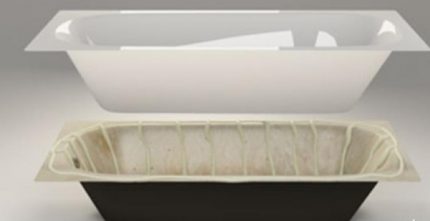
Before installing acrylic liner the bath needs to be prepared, but such careful preparation as before painting is not required. It is enough to remove the enamel coating with a grinding brush and then degrease the surface with a cleaning agent.
The liner must be tried on, if there are protruding parts, then they will have to be cut with an electric jigsaw. Next, holes for overflow and discharge are noted and cut out with a drill. Sealant is applied to the edges of the bath. The insert is installed on a special foam, which uniformly covers the entire surface of the bath.

The acrylic insert is carefully lowered into the container and installed so that there are no distortions. Then a siphon is connected, and the bath is almost completely filled with water. In this condition, it must be left for a day so that the foam and sealant are completely dry.
In this way, you can restore the bath yourself, but it is best to turn to the services of companies that will perform work at a professional level.
If you are in doubt about which restoration method to prefer, then read the article - Insert or bulk bath: comparison of technological and technical characteristics
Conclusions and useful video on the topic
Restoration of a cast-iron bathtub using special enamels:
Liquid acrylic bath coating:
Restoration of the bath using an acrylic liner:
Restoration is the best way to update the appearance of the bath, as it allows you to quickly, simply and inexpensively give new life to an old cast-iron bath. Each method has its pros and cons, so you decide which one to take into service.
Have experience restoring a cast-iron bath? Please share information with our readers, suggest your own way to solve the problem. You can leave comments in the form below.

 How to wash a cast-iron bath without damaging enamel: a review of folk recipes and the best purchased products
How to wash a cast-iron bath without damaging enamel: a review of folk recipes and the best purchased products  How to update an old cast-iron bath: a review of restoration and repair work
How to update an old cast-iron bath: a review of restoration and repair work  How to choose a cast-iron bathtub: valuable tips for choosing plumbing fixtures from cast iron
How to choose a cast-iron bathtub: valuable tips for choosing plumbing fixtures from cast iron 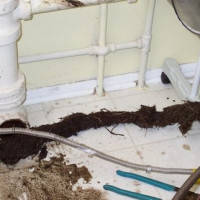 How to eliminate clogging in the bathroom: an overview of the best ways to clean the sewer
How to eliminate clogging in the bathroom: an overview of the best ways to clean the sewer 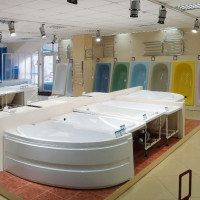 How and which bath is best to choose: an overview of options and recommendations for choosing
How and which bath is best to choose: an overview of options and recommendations for choosing 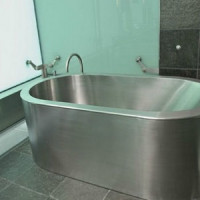 How to choose a steel bath: what to look at when choosing + manufacturers overview
How to choose a steel bath: what to look at when choosing + manufacturers overview  How much does it cost to connect gas to a private house: the price of organizing gas supply
How much does it cost to connect gas to a private house: the price of organizing gas supply  The best washing machines with dryer: model rating and customer tips
The best washing machines with dryer: model rating and customer tips  What is the color temperature of light and the nuances of choosing the temperature of the lamps to suit your needs
What is the color temperature of light and the nuances of choosing the temperature of the lamps to suit your needs  Replacement of a geyser in an apartment: replacement paperwork + basic norms and requirements
Replacement of a geyser in an apartment: replacement paperwork + basic norms and requirements
I have just had a cast-iron bathtub since the 80s. I tried to paint it with epoxy enamel - it's a simple matter, but the method is unreliable, a year later the enamel began to peel off. I found out about the acrylic insert: this costs a lot, and yet it reduces the internal volume of the bath. The most normal option is acrylic. For three years now I have a bath painted with acrylic, it looks like new and has not peeled off.
Our bath is about forty years old. My washing it, but the view is not the same. I would like to restore, but I don’t know how to do it better. Is there no spray paint? This is not mentioned here. And for me, this type of restoration is much more attractive: both quickly and evenly. A brush will have to work hard, and to achieve a uniform coating, it seems to me, it will not work.
Acrylic exists in aerosols, but it is much worse than usual. It is less durable, since it is applied in a thin layer and contains a solvent in the composition. Plus non-professional easier to apply acrylic with a brush. After improper aerosol application, smudges will remain.
Hello. There is such a paint in 3 versions, with different advantages and disadvantages:
1. Epoxy enamel - toxic when stained, hardens quickly, provides uniform coverage, but is difficult to paint without drips. If you paint without color, with white color, it quickly loses its whiteness resistance, but in general, the coating is durable and resistant to abrasion.
2. Acrylic - it is better to use the bulk method. It has a reduced thermal conductivity, durable, resistant to color loss. Also very toxic. When caring for the coating, alkalis and acids cannot be used. It is recommended to apply accurately and accurately, avoiding gaps.
3. Alkyd paint - it is difficult to apply and spend in large quantities. But overall, it is non-toxic and retains color for a long time.
What is the minus of the paint in the spray cans? This is a difficult adjustment and a thin coating layer. Well, of course, you need to almost perfectly prepare the surface.
How to paint:
1. Cover with a film non-working surfaces.
2. Wear a face shield, gloves and old clothing.
3. Clean the appliance from dirt, rust.
4. Remove any old coatings with an emery cloth or grinder.
5. After that, rinse the bath thoroughly and dry it.
6. Treat with solvent, primer.
7. Shake the spray can.
8. From a maximum vertical position from a 30-cm distance, spray paint with a thin, uniform layer.
9. If there are problems, fix them with a rubber spatula.
10. Use paint according to the manufacturer's instructions.